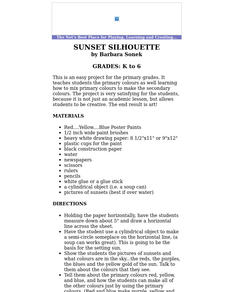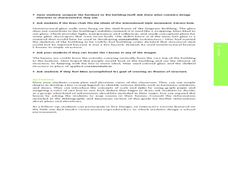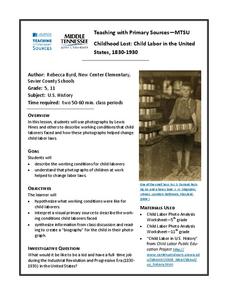Curated OER
Vincent's Flowers
Students create original works of "sunflower" art using Van Gogh's paintings and the book "Camille and the Sunflowers" as a basis. Pastels and sugar paper are the suggested medium for this creative project.
Curated OER
Interpreting Lao Design Drawing
Students identify symmetry as a word and concept using drawings. The activity is cross-cultural using traditional Lao Art. The goal is to then apply the skills of symmetry to personal works of art that are produced.
Curated OER
Understanding and Fighting Stereotypes through Words and Images
Use some provocative modern art to get your class considering stereotypes and the impact they have on us all. Your class will discuss the print art Indian Look-Alike by Melanie Yazzie and stereotypes in general before...
Denver Art Museum
Alien Beauty
"Beauty is in the eye of the beholder," is a popular phrase in our society. The instructional activity here puts the phrase to the test as pupils explore what truly is beautiful through a study of some Japanese folk art. A careful...
Denver Art Museum
Tea Gathering Quick-Write
Japanese tea gatherings are the inspiration for a great lesson. Learners are provided with an image of a tea caddy made for thick tea and asked to describe what they notice and what that might mean. This leads into a larger lesson about...
Curated OER
Mixing Primary and Secondary Colors
Pupils use Play Doh to make a color wheel. In this color wheel lesson plan, students use primary and secondary colors of Play Doh to make a color wheel.
Curated OER
Sunset Silhouette (primary colours)
Students draw and paint the sunset, learning about the primary colors while painting and mixing.
Curated OER
Weaving a Watercolor
Students examine the color wheel and work with watercolors. In this color lesson, students go over primary, secondary, and intermediate colors before watching a demonstration of watercolor brush techniques. They choose a shape to paint...
Curated OER
Color Theory & Using Layers
Students investigate the color wheel theory and incorporate it into simple sketches on their handheld. The importance of the use of layering and the difference between primary, secondary, and tertiary colors is presented in this lesson.
Curated OER
Pictures from Korea: Shards of an Almost Forgotten Past
Students explore the Korean War through photography. In this Korean War instructional activity, students examine photographs taken by a soldier and respond to question about them.
Curated OER
Tissue Paper Butterfly
Creating butterfly art is as simple as 1-2-3. Kids cut coffee filters into butterfly shapes. Next, they wet and place squares of tissue paper onto the filters. Fifteen minutes later, they lift the tissue to reveal a colorful pattern...
Curated OER
Exploring the Design Process
Students analyze the design process and architecture of Ludwig van der Rohe. In this architecture and art analysis lesson, students explore the design process through photographic documentation and architectural plans. Students use...
Curated OER
Childhood Lost: Child Labor in the United States, 1830-1930
Working in groups, middle and high schoolers describe and discuss photographs depicting working conditions experienced by child laborers in the 19th century. They then write a persuasive paragraph supporting an amendment to regulate the...
Curated OER
Influential People Taking A Stand
Seventh graders explore how influential people have taken a stand on difficult issues and the consequences that followed. This lesson connect American studens with students in England who present their own person for exploration.
Curated OER
The Circulatory System--Part VI
Students outline a body on butcher paper. Students fill in the circulatory system using materials of various textures. Students decorate all the parts of the circulatory system with art articles, like buttons, yarn, etc.
Curated OER
The Blues, B.B. King, Muddy Waters
B.B. King and Muddy Waters are two of the most famous blues performers of all time. In this music activity, middle schoolers study the early careers and lasting musical contributions of both artists, each of whom carried the blues on to...
Curated OER
How Are Colors Created?
Kids explore primary and secondary colors, as well as the concepts of tints and shade in a series of color lessons. The packet includes detailed directions for how to use BrainPOP Jr. resources to create learning...
Concordia College Archives
Introduction and Student Inquiry
Introduce young musicians to the history of and different styles of music with an inquiry-based learning activity that asks them to play detectives to determine the similarities and differences among the sheet music found at a series of...
National Woman's History Museum
Propaganda and Women's Suffrage
Americans who backed the suffragist movement used posters to gain the support of others for their cause. Class members analyze the visual imagery and propaganda devices used in a variety of these posters. In addition, groups examine how...
American Battlefield Trust
Antietam 360
It was the single bloodiest day in Civil War history. Now, class members have the opportunity to walk in the footsteps of soldiers who fought in the Battle of Antietam using an interactive website. Supplemental resources include...
Curated OER
The Language of Ballet
Here's a very well organized lesson plan on learning the terminology of ballet. Learn the names of some basic positions, and how to perform them. Learn the names, which happen to be in French, of basic movements in ballet. Not only are...
NET Foundation for Television
1850-1874 Notable Nebraskan: J. Sterling Morton
What are the characteristics of an outstanding citizen? Nebraskan J. Sterling Morton contributed to the formation of societal and family values in his state. Learners gather information on Morton's life accomplishments from primary...
Curated OER
A Deeper Shade of Purple
Third graders explore the color purple. For this visual arts lesson, 3rd graders sort purple objects in various ways and create the color purple by mixing paint. Students create a purple portrait of a character from the play, Lost and...
Curated OER
Tin Can Telephone
Students make telephones. In this visual arts lesson, students follow the provided steps to create their own tin can telephones.

























